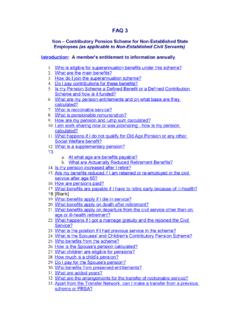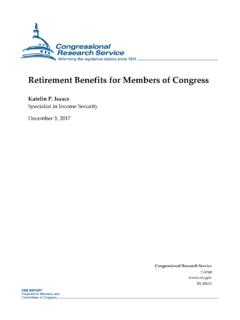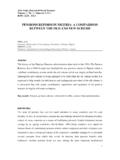Transcription of FAQ 1 - cspensions.gov.ie
1 FAQ 1. Established Civil Servants (including Prison Officers) who pay Modified (Class B) PRSI and are not making an employee contribution in respect of personal superannuation benefits Introduction: A scheme member's entitlement to information annually. 1. Who is eligible for superannuation benefits under this scheme? 2. What are the main benefits? 3. How do I join the superannuation scheme? 4. Do I pay contributions for these benefits? 5. Is my Pension Scheme a Defined Benefit or a Defined Contribution Scheme and how is it funded? 6. On what basis are my pension benefits calculated? 7. What is reckonable service? 8. What is pensionable remuneration? 9. How are my pension and lump sum calculated? 10. I am work-sharing now or was job-sharing how is my pension calculated? 11. a. At what age are benefits payable? b. What are Actuarially Reduced Retirement Benefits? 12. Is my pension increased after I retire? 13. Are the benefits reduced if an officer is retained or re-employed in the civil service?
2 14. How are pensions paid? 15. What benefits are payable if I have to retire early because of ill-health? 16. What is a short service gratuity? 17. What benefits apply if I die in service? 18. What benefits apply on death after retirement? 19. What benefits apply on departure from the Civil Service other than on age or ill-health retirement? 20. Who is eligible for a marriage gratuity? 21. What happens if I got a marriage gratuity and then rejoined the Civil Service? 22. What is the Spouses' and Children's Contributory Pension Scheme? 23. How is the spouse's pension calculated? 24. What children are eligible for pensions? 25. How much is a child's pension? 26. Do I pay for the Spouse's pension? 27. Who benefits from preserved entitlements? 28. What are added years? 29. What are the arrangements for the transfer of reckonable service? 30. Apart from the Transfer Network', can I make a transfer from a previous pension scheme or PRSA? 31. What is the Purchase Scheme? 32.
3 What are AVC's? 33. What is an Injury Warrant and what does it cover? 34. Can I allocate part of my pension? 35. How are benefits and contributions treated for income tax purposes? 36. What happens to my pension if I get divorced or separated? 37. Is account taken of any entitlements under the Social Welfare Acts in calculating my benefits under this Scheme? 38. Where can I get information on Social Welfare entitlements? 39. Where can I get more information? Back to Top Annex 1 - A Scheme Member's entitlement to information Disclaimer Established Civil Servants (including Prison Officers) who pay Modified (Class B) PRSI and are not making an employee contribution in respect of personal superannuation benefits Introduction: A scheme member's entitlement to information annually. As provided by Regulations made under the Pensions Act. A member of this pension scheme is, each year, entitled to certain information. This information is outlined in Annex 1. 1. Who is eligible for superannuation benefits under this scheme?
4 All eligible civil servants over 16 years of age are eligible for superannuation benefits as outlined below. These FAQ's deal with officers appointed before 6 April 1995 who do not pay Class A PRSI. They pay a modified (Class B) rate of PRSI and they do not pay any personal contributions. 2. What are the main benefits? The main benefits are: Retirement pension and lump sum (questions 6 to 12);. Death gratuity (question 17);. Marriage gratuity (applies to staff appointed from competitions advertised before 1 February, 1974) (question 20);. Spouses' and children's pensions (questions 22 to 26). Other aspects of superannuation covered; are: Actuarially reduced benefits (question 11(b));. Preserved benefits (question 27);. Notional service (question 28);. Transfer of service (question 29) and Transfer Value (question 30);. Purchase of Service (question 31);. Additional Voluntary Contributions (AVC's) (question 32);. Allocation of pension (question 34);. Income tax treatment of pension (question 35).
5 Divorce or separation (question 36). Annex1. 3. How do I join the Superannuation Scheme? All officers over age 16 on becoming Established Civil Servants are automatically included in the Established Superannuation Scheme; it is a condition of service. 4. Do I pay contributions for these benefits? There is no personal contribution towards their own personal pension for officers who pay modified PRSI. Officers pay contributions of 1 % of pay for spouses' and children's pension benefits. For job-sharers and work-sharers, contributions are calculated on a pro rata basis. Back to Top 5. Is my Pension Scheme a Defined Benefit or a Defined Contribution Scheme and how is it funded? Your scheme is a Final Salary Defined Benefit Scheme which gives a pension based on service and final pensionable remuneration (salary and pensionable allowances) see question 6. The scheme is an unfunded Pay-as- you-go scheme. The amount of pension benefit is defined in the scheme rules and is not affected by investment returns etc.
6 Scheme benefits are payable from monies voted by the Oireachtas to Vote 7 . Superannuation and Retired Allowances. The pensions benefits payable compare favourably with benefits from comparable private sector schemes. Another way of looking at this is how much would you have to pay in a once-off payment at retirement to buy the benefits in the private market. If you retired as a HEO on a full pension at age 65 then it would cost you about 690,000 to buy the equivalent benefits in the private market. It would cost a PO about 1,340,000 to buy the equivalent benefits. Back to Top 6. On what basis are my pension benefits calculated? On retirement you will be entitled to a pension and lump sum, provided you have a minimum of 2 years qualifying service. Pension and lump sum payments are determined by: Total reckonable service (based on completed years and days of service), and Pensionable remuneration on the last day of service If you change grade in the last three years ( on promotion).
7 Pensionable remuneration is based on the average of the salaries paid in the last three years. 7. What is reckonable service? Reckonable Service is: Full-time paid, established service;. Job-sharing or work-sharing service (see question 10);. Non-established service given before appointment to an established post;. Certain part-time service (on a pro rata basis);. Additional service or added years granted in certain circumstances (question 28);. Transferred service (question 29) and Service purchased with a Transfer Value (question 30);. Purchased service (question 31). For established Civil Servants in paid employment service on or after 20th December 2001, part-time service prior to that date may reckon as follows: for service given prior to 1st June 1973, where the hours worked were at least 18 hours per week, the service will reckon on the basis of one half of comparable full-time service;. for part-time service on or after 1st June 1973, where the hours worked were at least 8 hours per week, the service will reckon in the proportion which the hours worked bear to comparable full-time service.
8 The reckoning of earlier service may involve the payment of appropriate 'back' contributions and other conditions - see Circular 20/2005 paragraph 39. Periods of leave without pay are not reckonable but a break in service, a career break, does not affect the aggregation of reckonable service reckonable service before the break may be aggregated with reckonable service after the break. Periods on pension rate of pay are not reckonable. Back to Top 8. What is pensionable remuneration? Generally, pensionable remuneration is final pay ( salary payable on the last day of reckonable service), plus, effective from 1st April 2004 the average of the best of three consecutive years' pensionable allowances in the final ten years of service. The benefits may, in some cases be based on an average salary. For instance, if, within the last 3 years of service, an officer has changed grade ( been promoted) or received a personal change in pay, an average pay figure will be used which takes account of the final salary and the salary of the former grade and the relative periods spent in the two grades in the last 3 years.
9 Where the person is retiring on grounds of ill-health, averaging does not apply if the person had the potential for service to avoid the averaging. 9. How are my pension and lump sum calculated? Subject to a minimum requirement of 2 years' qualifying service, pension and lump sum are payable for each year of reckonable service (part year service is reckoned on a pro-rata basis). Pension: The pension is 1/80th of gross pensionable remuneration for each year of reckonable service subject to a maximum of 40/80ths ( . pensionable remuneration). Lump Sum: The lump sum is 3/80ths of gross pensionable remuneration for each year of reckonable service subject to a maximum of 120/80ths. This payment is currently tax free. [For Prison Officers service greater than 20 years is doubled for the purposes of the above calculations. The maximum reckonable service is 40 years]. As indicated above, part years of service are reckoned on a pro-rata basis. Example: A HEO on a salary of 44,029 retires from the Civil Service at age 65 after 35 years service.
10 Pension = 44,029 * 1/80 * 35 = 19, Lump Sum = 44,029 * 3/80ths * 35 = 57, Officers entitled to preserved benefits receive a pension lump sum based on pensionable remuneration at the date of resignation up-rated by the appropriate pay increases between that date and their 60th birthday. Back to Top 10. I am work-sharing now or was job-sharing how is my pension calculated? You have your worksharing or job-sharing service treated on a pro-rata basis and the pensionable remuneration is the notional full rate of pay for the job. This means that the period of jobsharing/worksharing service is reckoned pro-rata to whole time reckonable service and the salary base is the whole time equivalent salary. 11. At what age are benefits payable? (a) Provided an officer has a minimum of 2 years' qualifying service, benefits are payable on retirement either at maximum retirement age of 65 (60 in the case of Prison Officers) or at any time after reaching age 60 (55 in the case of Prison Officers).











